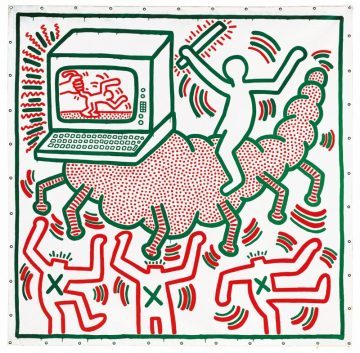Thomas Calvocoressi in New Statesman:
 March 2019: a woman is standing in front of some Swatch watches on a daytime TV antiques show. The presenter asks which is her favourite. “Probably this one,” she answers, pointing to a watch adorned with a cartoon barking mutt. “I just like the dog – it makes me smile.” The story of how Keith Haring’s symbols became so ubiquitous that they ended up on the wrists of Middle England as much as on the bedroom walls of 1980s Aids activists is both the contradiction and the genius of the New York street artist, whose star burned fast and acid bright. Tate Liverpool’s superb retrospective traces Haring’s ten-year flight from street artist to global consumer brand, from scrawling on the subway to painting the Berlin Wall, and details the turbulent political backdrop behind his work. We know many of his motifs well – the dog, the crawling baby, the three-eyed face – his thick black lines and dancing figures, but there’s nothing superficial about these deceptively simple scrawls.
March 2019: a woman is standing in front of some Swatch watches on a daytime TV antiques show. The presenter asks which is her favourite. “Probably this one,” she answers, pointing to a watch adorned with a cartoon barking mutt. “I just like the dog – it makes me smile.” The story of how Keith Haring’s symbols became so ubiquitous that they ended up on the wrists of Middle England as much as on the bedroom walls of 1980s Aids activists is both the contradiction and the genius of the New York street artist, whose star burned fast and acid bright. Tate Liverpool’s superb retrospective traces Haring’s ten-year flight from street artist to global consumer brand, from scrawling on the subway to painting the Berlin Wall, and details the turbulent political backdrop behind his work. We know many of his motifs well – the dog, the crawling baby, the three-eyed face – his thick black lines and dancing figures, but there’s nothing superficial about these deceptively simple scrawls.
They’re angry, anguished and urgent, as well as being joyous and optimistic. Apartheid, homophobia, HIV; hedonism, sexual liberation and the power of love. His influences range across cartoons, hip hop, video games, Egyptian hieroglyphics, Japanese calligraphy and Art Brut. Above all they fizz with a relentless energy; the feeling that Haring is in a (very real) race against time to cover every surface.
Having moved from small-town Pennsylvania to New York in 1978 to go to art college, he began honing an artistic language that used symbols to express his social message. The subway became his canvas. While other graffiti artists were spraying paint on walls, Haring chose white chalk for his strikingly effective sketches, like post-industrial cave paintings, allowing him to reach the largest and most diverse possible audience. And they were certainly noticed. Videos showing commuters’ reactions to his guerrilla art are amusing to watch: some disapproving, others enthralled. What is striking is the grimness of the setting: early-1980s New York was hollowed out, depressed and bankrupt. In contrast, Haring’s work is overwhelmingly positive – a gift to the public. Alongside the pulsating bodies and TVs, the robots and breakdancers, come cheering messages: “New Year ’84”, “Happy Valentine’s”, “Still alive in ’85”.
More here.
